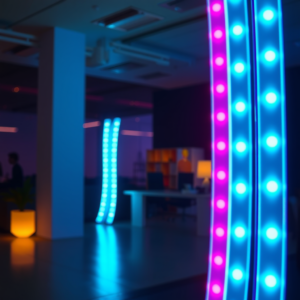What Are LED Lights and Why Are They Different?
Light Emitting Diodes, or LED lights, are a type of illumination based on the principle of solid-state, using the semiconductors which convert electrical energy into light. Unlike the traditional incandescent light and fluorescent light, LED uses considerably less power consuming about 80% less energy. In addition, it has a very long life with certain types operating for up to 50,000 hours. LED strip lights can be a fire hazard too if improperly installed. However, their energy efficiency and long lifespan make them a popular choice for modern lighting.
The technology in LED lighting vastly differs from that of older systems. Incandescent lamps generate light by heating an electric wire. The wire heats up until it glows. Fluorescent lamps work differently. They contain gas that gets excited to produce light.. Ways to make light bulbs in a cooler fashion, LEDs, use electroluminescence in producing light, so practically very little heat is generated.
In addition, LEDs are more environmentally sustainable, as they contain no mercury and are recyclable. The ability to work in different temperature ranges and conditions is what makes them ideal for places such as cold garages or hot kitchens. These qualities are the main reasons why people who are thinking about improving their lighting systems choose LEDs rather.
Can LED Lights Really Catch Fire?
While LEDs are generally safe, they can catch fire under certain conditions. Factors that may increase the risk include overheating and electrical issues, often due to improper installation or faulty parts.
Overheating can occur if LEDs are used in enclosed fixtures not designed for them making LED strip lights a fire hazard. LEDs require proper airflow to cool down. Blocking that airflow can lead to overheating, which, in extreme cases, can cause a fire.
There is also a risk associated with electrical problems. Short circuits or overloads can cause fire hazards due to improper wiring. Using incompatible dimmer switches can also lead to these dangers. It is essential for homeowners and electricians to ensure the compatibility and proper installation of all electrical parts, in order to mitigate these risks.
LEDs are less fire hazardous by virtue of their basic technology, but factors such as their modes of installation and the surrounding environment remain fundamental considerations for safety. As such, vigilance helps to mitigate these threats to a significant extent.
Safety Measures for Using LED Lights
LED lights may pose a fire danger if preventive measures are not taken. Here are a few safety measures that may help mitigate risk:
- Proper Installation:
- Only use LED strip lights compatible with the type of bulb installed, particularly when it comes to the dissipation of heat. Always install open fittings to provide necessary ventilation.
- Verify that all electrical connections and wiring are secure and compatible with the LEDs in use.
- Regular Maintenance:
- Conduct periodic evaluations to observe the condition of LED setups, paying special attention to the virus presence or any other damage for that matter. Also check for any change in color or flickering which may be an indicator of overheating as well as electric malfunctions.
- Keep the area around LED installations clean and free of dust or debris that could hinder cooling.
- Use Compatible Components:
- If using dimmers, ensure they are compatible with your LED lights. Not all dimmers work with LEDs, and using the wrong type can result in overheating or flickering.
- For strip lighting, use appropriate power supplies and never overload circuits.
By adhering to these guidelines, you can enjoy the benefits of LED lighting without compromising on safety.
Understanding Industry Standards and Regulations
LED light manufacturers must adhere to stringent safety standards and regulations to ensure their products are safe for consumer use. Organizations like the National Fire Protection Association (NFPA) and Underwriters Laboratories (UL) set these standards, offering guidelines on manufacturing, installation, and usage. For instance, the NFPA provides comprehensive codes related to electrical safety, while UL tests and certifies electrical products for safety compliance. Adherence to these standards is crucial for reducing the risk of fire and ensuring consumer safety.
Additionally, regulations enforced through industry bodies like IEEE Xplore ensure that LED products meet necessary safety prerequisites before reaching the market. These regulations provide a layer of assurance for both homeowners and electricians.
Conclusion
In conclusion, while LED lights offer numerous benefits over traditional lighting, they are not entirely without risks. With proper understanding and adherence to safety measures, the risk of an LED-related fire can be substantially minimized. Homeowners are encouraged to stay informed and vigilant, regularly inspecting their lighting setups and consulting professionals when necessary.
If you have experiences to share about LED lighting safety, we invite you to join the conversation and help promote safer lighting practices. For those considering new installations or upgrades, collaborating with certified electricians can provide peace of mind and ensure compliance with safety standards.
Previous